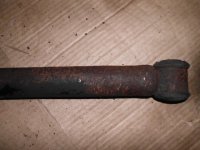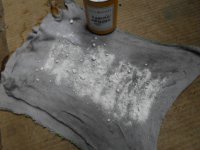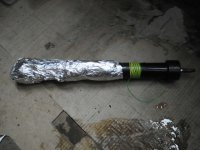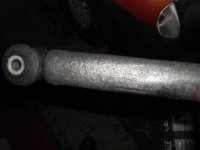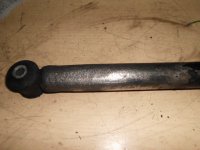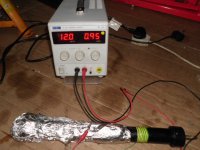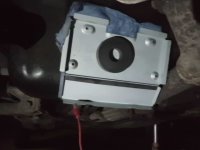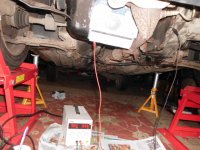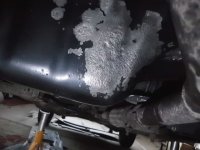My bonnet has started to go rusty, there's only one bath I can think of that's big enough to cope with it and.....er.....actually forget that one. Mrs. Beard's face when confronted with a large metal panel de-rusting is one I don't really want to see.Update
the panda is now back in service..with rusty hangers..
but I've got another "challenging bit of rust" to deal with..,
@6mm stud x 25 mm long - stuck in a plastic housing ( that I don't want to wreck..)
I'm going to use a car battery that's lost a cell,
and a tub of oxfordshires finest tap water
with a couple of jumper cables..
lets see how things work out..:chin:
Charlie
You are using an out of date browser. It may not display this or other websites correctly.
You should upgrade or use an alternative browser.
You should upgrade or use an alternative browser.
How to remove rust with just water.
- Thread starter Michael Dranfield
- Start date
Currently reading:
How to remove rust with just water.
rusty panda bonnet.. just from stone chips.. or more widespread..??
Robbyrob1273
New member
- Joined
- Dec 23, 2016
- Messages
- 21
- Points
- 3
I got great results with malasas, cheap as chips and the bath works for 6months
Robbyrob1273
New member
- Joined
- Dec 23, 2016
- Messages
- 21
- Points
- 3
Two weeks in the solution and all rust had gone. I sprayed the bare metal after with zinc etch primer. It still looks spotless ready to weld or paint 6 months later.
Two weeks in the solution and all rust had gone. I sprayed the bare metal after with zinc etch primer. It still looks spotless ready to weld or paint 6 months later.
Molasses..? sugary fluid
where did you buy it, and was it used as the sole fluid..??
Charlie
Absolutely correct,there is no point whatsoever rubbing down a pice of rusty metal with emery cloth and repainting because as you say one tiny spec of rust left will start to fester under the paint and before you know it rust is bubbling up again.
As soon as a part has been de rusted I wash it in clean water then immediately dry with a hot air paint stripper and paint with zinc galvanising primer , don't let the part air dry or paint it another day,it must be done immediately,bare metal can start to rust within a few hours in damp air.
I'm using a car battery @8V ( lost a cell or 2) will use an old starter-charger if necessary
:idea:my idea is to use a 1" ( 25mm steel rod -as the anode)
as I can skim off the rusty surface for further attempts..
Bath will use water and a little dishwasher salt at first..,
as I'm starting with small items, they'll get an hour in the oven to bake dry before a flash of primer
Charlie
Last edited:
Robbyrob1273
New member
- Joined
- Dec 23, 2016
- Messages
- 21
- Points
- 3
Check out the YouTube video this Australian guy has put up, it explains everything in detail and shows the results. I bought 5ltr bottles from a horse feed shop (it's used to flavour straw). I built a dip tank with pallets and a tarpaulin from diy shop. I dipped full doors, tailgate, engine lid plus loads of small parts. The tank was active for the whole summer with parts going through it. Saved me loads on parts and was great to weld straight after. The fluid goes inside and removes rust you can't get your fingers or tools near. Pity I can't post pictures.
Alas it appears to be the dreaded Polish tin-worm, a very close relation to the Italian tin-worm. It's manifested itself in a couple of small bubbles on the leading edge of the bonnet, it's the bit that sits at about 45 degrees, just inboard of the N/S headlight.rusty panda bonnet.. just from stone chips.. or more widespread..??
Sadly there are some more on the N/S sill just ahead of the rear wheel arch. I've already had the lower edge of the tailgate done. The bodyshop owner said that two factors played a part in the corrosion:
1: The rubber bungs that are supposed to guide moisture out were probably doing more harm than good.
2: As per countless others I've heard go on about it on here, the supplying dealer drilled into the tailgate rather than use the nylon type grommits fitted for the purpose.
OK guys so if you read my thread will see this fantastic method of removing rust for virtually free is only suitable for dipping items but what happens if the rusty part is still on the car or to big to be dipped such as a rear axial , so I had another idea, check this out.
Take an old dishcloth, well it is old now !!!!
soak it in plenty of water and sprinkle on some baking powder or better still soak it in in a solution of baking powder and water, wrap it tight round the rusty part and then cover it in tin foil to make the other electrode, dont use to much current as the heat will evaporate the water and break the circuit and leave it overnight.
Have a look at the photos I tested this on the old rear shock absorber I replaced on my wifes punto evo as you can see after just 1 day most of the rust has dissapeared and you can see bare metal, the only downside appears to be as the dishcloth forms a barrier between the two electrodes the rust does not migrate to the other plate and has to be scrubbed off with clean water afterwards and of course you may have to to this more than once to get a perfect result.
Any parts not directly in contact with the dishcloth will not be de rusted.
Take an old dishcloth, well it is old now !!!!
soak it in plenty of water and sprinkle on some baking powder or better still soak it in in a solution of baking powder and water, wrap it tight round the rusty part and then cover it in tin foil to make the other electrode, dont use to much current as the heat will evaporate the water and break the circuit and leave it overnight.
Have a look at the photos I tested this on the old rear shock absorber I replaced on my wifes punto evo as you can see after just 1 day most of the rust has dissapeared and you can see bare metal, the only downside appears to be as the dishcloth forms a barrier between the two electrodes the rust does not migrate to the other plate and has to be scrubbed off with clean water afterwards and of course you may have to to this more than once to get a perfect result.
Any parts not directly in contact with the dishcloth will not be de rusted.
Attachments
So here I had another idea, what happens if the item is flat and you cant wrap around ?
Same idea , this time I am using a flat piece of metal, soaked tissue paper and a powerful magnet out of an old magnatron to hold the plate tight on to a vertical surface, in this instance I am de rusting the sump on my newly acquired Fiat seicento .
Same idea , this time I am using a flat piece of metal, soaked tissue paper and a powerful magnet out of an old magnatron to hold the plate tight on to a vertical surface, in this instance I am de rusting the sump on my newly acquired Fiat seicento .
Attachments
Similar threads
- Replies
- 1
- Views
- 164


